I’ve always considered Kimber rifles something of an aspirational product for lunch-bucket hunters such as myself. Their classic lines coupled with their attention to detail, reputation for accuracy and quality call to us no less than a bespoke David Miller or Ryan Breeding rifle beckons the well-heeled. However, with prices courting the $1,500 mark, Kimber rifles have been just out of financial reach for many until recently. Kimber has introduced its Hunter line with prices starting at a more obtainable $891, making this a mid-priced bolt-action rifle by today’s standards.
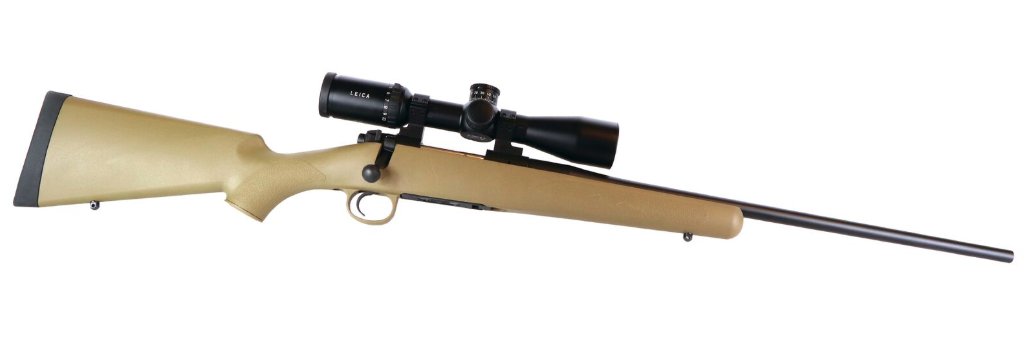
Kimber’s Hunter line of rifles puts the performance of a Kimber rifle in financial reach for more hunters.
According to Kimber’s Director of Marketing Communications, Jordan Hunter, the Kimber Hunter rifle was “made with intent” in response to Eastern hunters who wanted a rifle more in line with their needs. Though I am now a resident Western state hunter, I was an Eastern state hunter for the first 30 years of my hunting career. I can say authoritatively that the Kimber Hunter rifle is going to be right at home, whether your deer camp is in a snowy Vermont cabin or a breezy wall tent in the arid Southwest.
I say that because the features on the Hunter are the same features you’d want on any well-made deer hunting rifle.
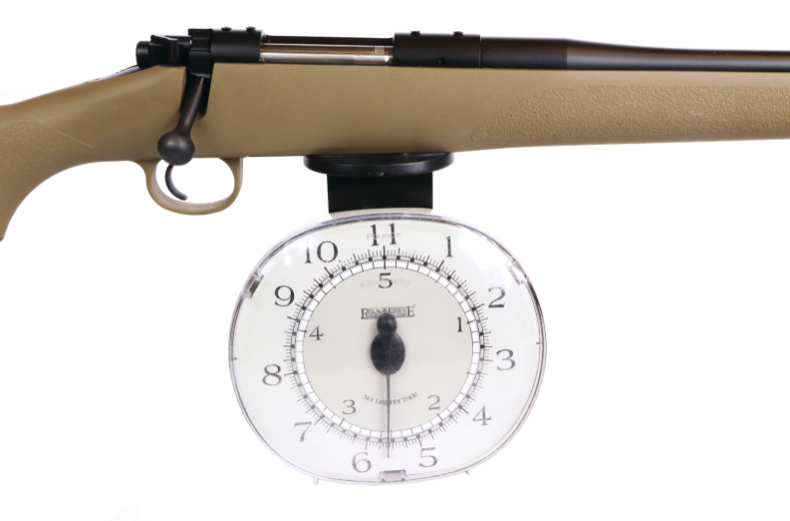
This svelte little rifle is catalogued at 5 pounds, 10 ounces. The sample gun tipped the scales at 5 pounds, 9 ounces.
At its heart is Kimber’s stainless steel 84 action and, while this rifle costs less than other Kimber lines using the exact same barreled actions, there is no cheapening. “The other rifle families have feature sets that are more expensive to manufacture,” explains Jordan of the price disparity. “For example, the Mountain Ascent and Montana feature performance lightening enhancements such as, a lighter stock, skeletonized bolt and bolt handle, as well as fluted and threaded barrels.”
What the Hunter does have, however, are such features as Kimber’s reliable controlled round feed, a high-quality lightweight stock, detachable magazine and adjustable trigger. “Often, people aren’t aware of the wide range of caliber offerings that are available for the Hunter line,” Jordan adds. Depending on exact model, Hunter chamberings include .243 Win., .257 Roberts, .25-’06 Rem., 6.5 Creedmoor, .270 Win., 7mm-08 Rem., .280 Ackley Improved, .308 Win. and .30-’06 Sprg. All are backed by Kimber’s sub-MOA accuracy guarantee that reads, “Kimber rifles are designed to be capable of shooting a 3-shot group of .99” or less at 100 yards by a highly skilled and qualified shooter using factory ammunition.”
While Jordan gave me a satisfactory answer as to why other Kimber rifles cost more, there are also some reasons why the Hunter costs less. Perhaps the biggest cost-saving measures on the Hunter are its stock and lack of bottom metal.
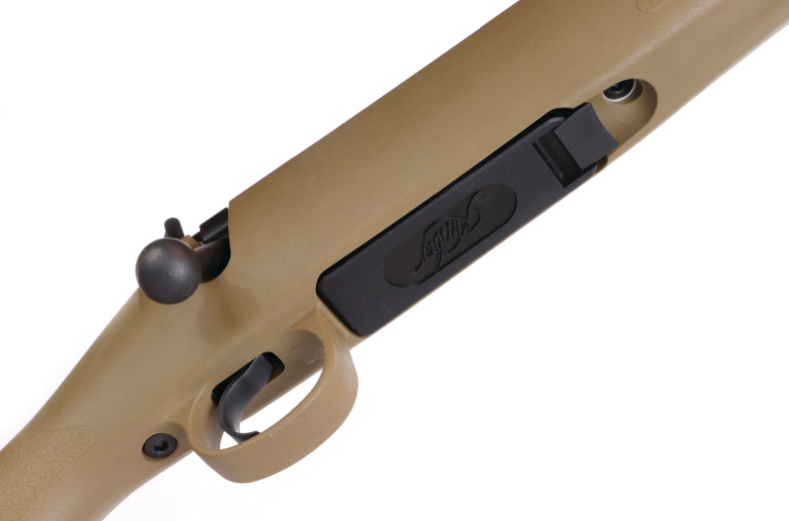
Cost saving measures include an injection-molded synthetic stock with integral triggerguard and detachable 3-round magazine with a synthetic floorplate.
The stock is a tough injection-molded synthetic material reinforced with a patent-pending honeycomb structure in the forend for added rigidity. George Hawthorn, Kimber’s rifle product engineer who developed the honeycomb, notes that the design “Improves the stock’s strength-to-weight ratio” and that it “adds rigidity under torsional loading.” In other words, it won’t twist if you’re wrapped up tightly in a sling, shooting at a big buck from a field position.
Jordan sums the new stock up more simply saying, “The design ensures long-term dependability and accuracy.” Though less expensive, the stock is several steps above utilitarian. Pillar bedding and full barrel free-floating aid accuracy potential, while stippled panels on the wrist and forend provide some added grip to an otherwise slick stock. It retains the classic straight American lines that direct recoil into your shoulder, not up and over or into the cheekbone. And what recoil isn’t mitigated by the straight design is tempered by a one-inch-thick rubber recoil pad.
Instead of a metal trigger guard, the Hunter’s is molded in as an integral part of the stock. It’s flush-fitting, three-round magazine has a synthetic floorplate and must be tipped in and out of the stock much like on an AK-47. However, on the Hunter, you tip the rear of the magazine in first, and the magazine release is in the front of the magazine box instead the AK’s receiver-mounted lever at the rear. Inserting the magazine takes a little getting used to, but it’s nothing a little range time won’t solve.
Kimber sent a Hunter Black chambered in .243 Win. for review. This variant differs from the others in the Hunter family in that its stainless steel action parts and barrel are blackened with Kimber’s matte KimPro II finish that reduces reflection and is tough, so it stands up against the elements and abuse. The stock is flat dark earth-colored. Other rifles in this family are available with various camouflage patterned stocks and natural stainless steel. Additionally, all have an adjustable trigger set at the factory between 3 1/2 and 4 pounds of pull.
I topped the Hunter Black with a 30mm Leica Magnus 1.5-10x42 scope. Ordinarily I’d think this is a physically too large an optic to put on such an ultra-light gun. However, it worked great. The gun remained nimble and well balanced, came quickly to the shoulder and stayed steady on target from various field positions. Maybe I’m just getting used to 30mm scopes as they become more the rule than the exception, but in my opinion, the comparatively large optic did nothing to diminish the svelte, trim look Kimber strives for in its rifles.
I started shooting with my go-to .243 Win. factory load — Hornady’s 100-grain Interlock. My wife, kids and I used that load almost exclusively for many years on our personal whitetail deer hunts when we lived back east. There’s nothing sexy about it — it’s just accurate and kills deer — plus, I know what to expect from it.
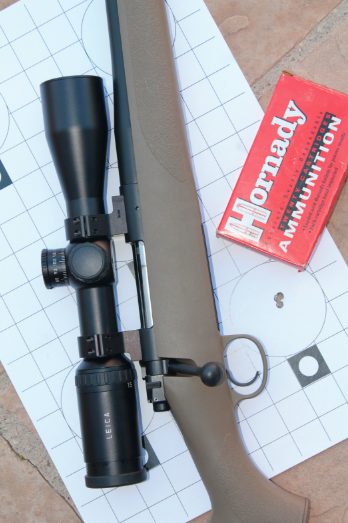
It took a few rounds to settle things in before the Kimber Hunter was regularly punching sub-MOA groups.
When the Kimber started giving me 1 1/2-inch groups with it, I was a little shocked and sadly disappointed. Three groups in, though, it was as if a switch flipped. Groups shrunk from 1 1/2 inches to all subsequent ones being sub-1/2-inch, including one bug-size group that measured a tiny 0.26-inch. Clearly, this Hunter more than lived up to Kimber’s accuracy expectations and guarantee.
I clean the bores of rifles between loads so each one has an equal and fair starting point, and maybe that was a mistake with the Kimber Hunter. The next load I tried was Federal’s Fusion 95-grain soft-point — the one with the boron nitride coated bullet. I had never used that load before and didn’t know what to expect, so I did a little research on it. Judging from the comments on various websites, it seems many guns don’t like this load, and neither did this Kimber. Though Federal still lists the load (F243FS1), it does not currently identify it as coated, so maybe the coating for this bullet was one of those things that seemed like a good idea at the time, yet wasn’t.
Comments from Hunter rifle owners suggest that the group shrinkage I experienced with the Hornady load might not be an isolated incident. One of Cabela’s verified purchasers, WestslopeJR, comments of his Hunter, “Accuracy from the Kimber was highly variable with 7–8 different kinds of factory ammo through the first 60-100 rounds. Now with over 200 rounds it reliably shoots 3 shot groups of 1 MOA or better...” This is not an indication of any “problem” with Hunter rifles; some individual guns simply “settle in” and then continue to shoot more accurately.
Other owners got their sub-MOA accuracy right out of the box. Byjherald posts on Cabela’s website, “Sub MOA with the first loads I fired through it at 100 yards,” and By1longshot calls his Kimber Hunter in .243 Win. an “amazing little rifle” and that “the first five shots down the pipe at 100 yards could be covered with a dime.”
So as it is with all rifles, Kimber Hunters are each unique with individual ammunition likes and dislikes.
Overall, I’d call the Kimber Hunter a world-class rifle that happens to have a mid-level price tag. Jordan suggested that with the Hunter line, Kimber learned many lessons in the way it manufactures that will enable the company to maintain the highest quality standards, but still offer a price point that appeals to a broader range of customer.
When owners think of their Kimber Hunter rifles, Jordan says he “hope[s] they think of quality, reliability and all at an incredible price point.” To him, those who pass on the Kimber Hunter do so simply because they have a hunting style that is so specific that they need specialized equipment.
Spec Sheet
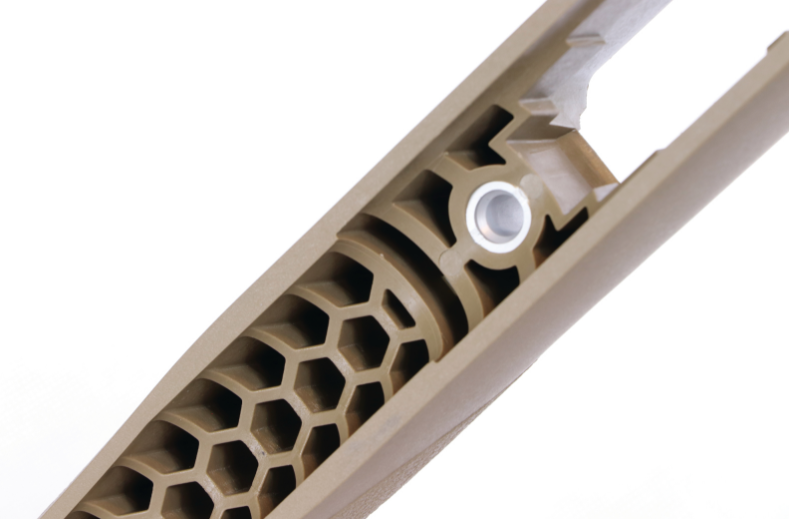
A honeycomb structure in the stock’s forend improves the stock’s strength-to-weight ratio and adds rigidity under torsional loading.
MANUFACTURER: Kimber
MODEL: Hunter Black
CALIBERS: .243 Win., .257 Roberts, .25-’06 Rem., 6.5 Creedmoor, .270 Win., 7mm-08 Rem., .280 Ackley Improved, .308 Win. and .30-’06 Sprg.
ACTION: Bolt-action repeating rifle
MAGAZINE CAPACITY: 3
BARREL: 22-inch stainless steel, KimPro II black finish
TRIGGER: adjustable 3.7 pounds pull
SIGHTS: None. Drilled and tapped for scope bases.
STOCK: Injection-molded synthetic, flat dark earth color.
OVERALL LENGTH: 41 1/4 inches
WEIGHT: 5 pounds, 9 ounces
OTHER: Match grade chamber, pillar bedding
MSRP: $945
MORE INFORMATION: www.kimberamerica.com






